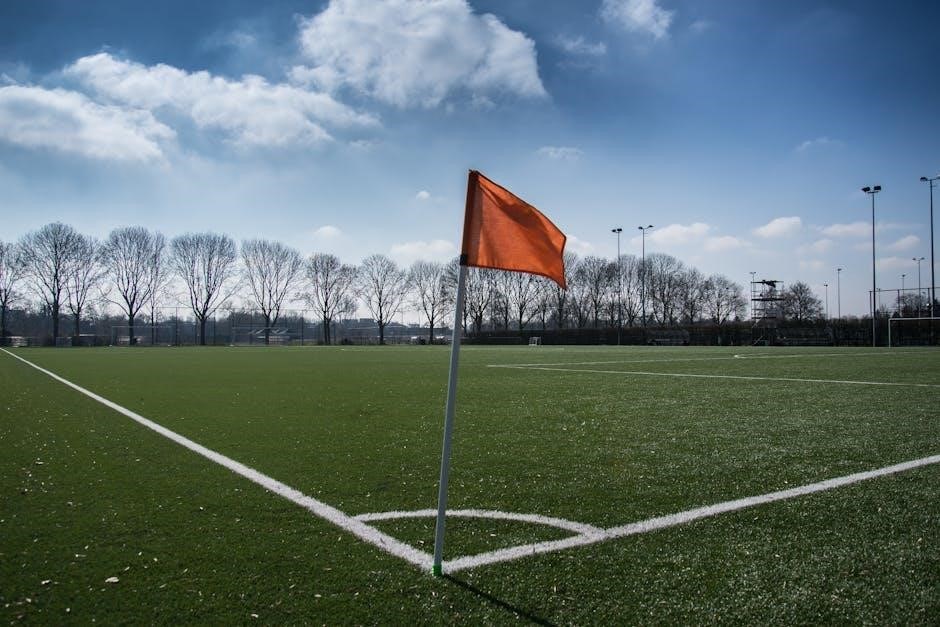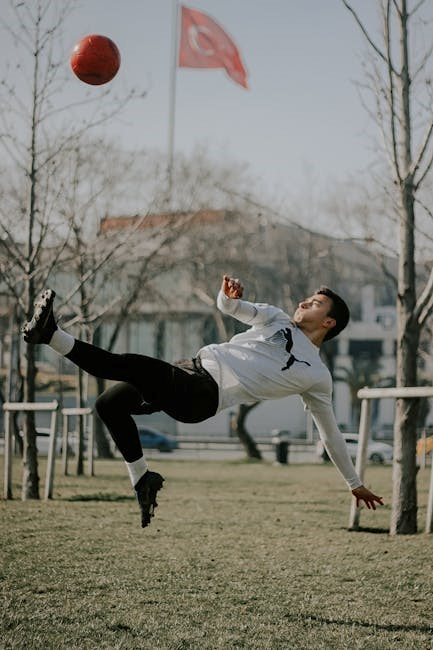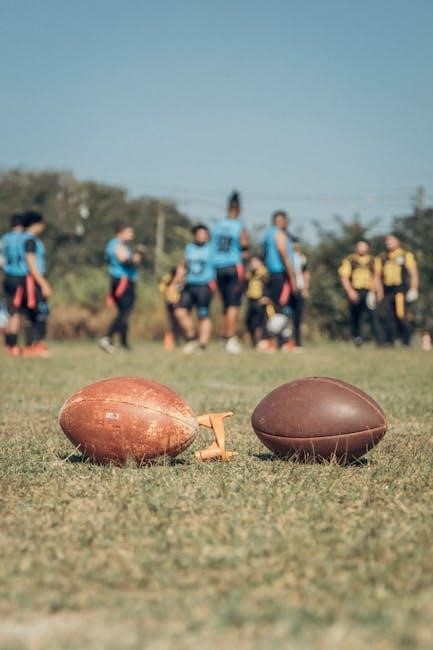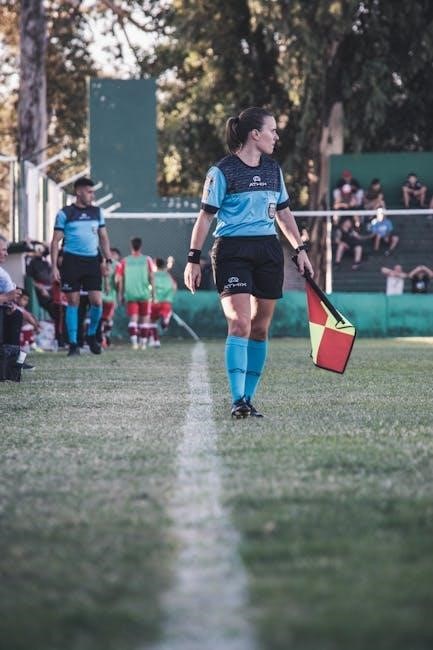5v5 flag football plays are essential for coaches and teams, offering strategies to outsmart opponents. Playbooks provide structured approaches for both offensive and defensive success, ensuring effective tactics and skill development for youth and adult teams alike.
1.1 Overview of Flag Football

Flag football is a fast-paced, non-contact variant of traditional football, emphasizing speed, agility, and strategy. Played with five players per team, it focuses on pulling flags from opponents rather than tackling. The game is popular in youth leagues and recreational play due to its safety and accessibility. It promotes skill development, teamwork, and physical fitness while maintaining the core principles of football. The smaller team size allows for more involvement and dynamic playmaking, making it an ideal format for developing players and enjoying competitive fun.
1.2 Importance of Playbooks in 5v5 Flag Football
A well-structured playbook is vital for success in 5v5 flag football, providing a clear framework for offensive and defensive strategies. It organizes plays, ensuring players understand their roles and responsibilities. Playbooks simplify complex strategies, making them accessible for youth and adult teams alike. They also allow coaches to adapt plays to their team’s strengths and opponents’ weaknesses. With detailed diagrams and color-coded systems, playbooks enhance teamwork, execution, and in-game adjustments, making them an indispensable tool for competitive play and skill development.

Key Formations in 5v5 Flag Football
Key formations in 5v5 flag football include spread, trips, stack, double-back, and single-back setups. These formations create strategic advantages and dictate player positioning for effective plays.
2.1 Spread Formation
The spread formation is a popular setup in 5v5 flag football, designed to maximize field space and create mismatches. Players line up wide, stretching the defense thin. This formation often features multiple receivers running routes such as slants, fades, and posts, aiming to exploit defensive weaknesses. The quarterback has clear passing options, while the spread also allows for effective run plays by isolating defenders. Coaches frequently use this formation to initiate quick passes and control the tempo of the game, making it a cornerstone of offensive strategies in flag football playbooks.
2.2 Trips Formation
The trips formation in 5v5 flag football features three receivers lined up on one side of the formation, creating a numerical advantage. This setup forces defensive adjustments, often leaving one-on-one matchups elsewhere. The trips formation is ideal for exploiting defensive weaknesses, as it overloads one side, making it difficult for defenders to cover all receivers. Popular routes include slants, screens, and deep posts, designed to isolate receivers or create confusion. Quarterbacks can quickly identify mismatches and deliver passes to open targets, making this formation a versatile offensive tool in flag football playbooks.
2.3 Stack Formation
The stack formation in 5v5 flag football involves grouping receivers closely together, creating a clustered look that challenges defensive alignment. This setup allows for intricate route combinations, such as crossing patterns and pick plays, designed to confuse defenders. The quarterback benefits from multiple targets in a small area, making it easier to find open receivers quickly. The stack formation is particularly effective for short, precise passes and screens, exploiting defensive mismatches and creating traffic that complicates coverage. It’s a versatile option for coaches seeking to control the tempo and create scoring opportunities effectively.
2.4 Double-Back Formation
The double-back formation in 5v5 flag football places two running backs behind the quarterback, creating a strong rushing threat. This setup allows for effective handoffs and play-action passes, forcing defenders to commit to the run. The double-back formation is ideal for teams looking to control the tempo of the game and exploit defensive weaknesses. It also provides misdirection opportunities, making it difficult for opponents to anticipate the next play. This formation is particularly useful for short-yardage situations and can be adapted to various offensive strategies, enhancing overall team flexibility and scoring potential.
2.5 Single-Back Formation
The single-back formation in 5v5 flag football features one running back positioned deep, allowing for a balanced attack. This setup enables quick passes and rushing plays, keeping defenses guessing. Receivers are often spread wide, creating mismatches and openings for big plays. The single-back formation is versatile, adapting to various offensive strategies. Coaches can use motion to shift the running back, exploiting defensive weaknesses. This formation is ideal for teams seeking flexibility and the ability to exploit defensive gaps effectively in both passing and rushing situations during the game.

Offensive Strategies
Offensive strategies in 5v5 flag football focus on play action, misdirection, and exploiting defensive gaps. These tactics maximize quarterback options and create scoring opportunities through precise execution and timing.
3.1 Basic Passing Plays
Basic passing plays in 5v5 flag football are designed to create quick, high-percentage completions. These plays often feature short routes such as slants, hooks, and outs, allowing the quarterback to deliver the ball rapidly to receivers in open spaces. By focusing on timing and accuracy, these plays help establish rhythm and control the tempo of the game. They are especially effective against man-to-man coverage and are foundational for building a balanced offensive attack.
3.2 Running Plays
Running plays in 5v5 flag football focus on exploiting defensive gaps and utilizing speed. Plays like the “Dive” or “Sweep” involve handoffs to the running back, aiming to quickly advance the ball. Misdirection plays, such as reverses, confuse defenders and create open lanes. These plays are crucial for controlling the clock and setting up play-action opportunities. Coaches often use them to test the defense’s agility and reaction time, making them a versatile tool in any offensive strategy.
3.3 Play Action Plays
Play action plays are deceptive strategies that mimic running plays to lure defenders, creating openings for pass completions. These plays often involve a fake handoff to the running back, freezing the defense. The quarterback then pulls back to pass, targeting receivers on routes like slants or deep posts. Effective play action plays rely on realistic fakes and timely execution. They are particularly effective against aggressive defenses, often resulting in significant gains. Playbooks highlight these plays to exploit defensive weaknesses and maximize offensive potential.

Defensive Strategies
Defensive strategies in 5v5 flag football focus on disrupting opponents’ plays. Techniques like man-to-man, zone coverage, and blitz packages are used to pressure the quarterback and limit offensive options effectively.
4.1 Man-to-Man Coverage
Man-to-man coverage is a fundamental defensive strategy in 5v5 flag football, where each defender is assigned to cover a specific offensive player. This approach requires quick reactions and strong one-on-one skills to mirror the opponent’s movements. Proper alignment and communication are crucial to avoid gaps in coverage. Defenders must stay disciplined, anticipating cuts and routes while maintaining containment. Effective man-to-man coverage can disrupt the offense’s timing and create opportunities for flag pulls or interceptions, making it a cornerstone of defensive playbooks.
4.2 Zone Coverage
Zone coverage in 5v5 flag football involves defenders protecting specific areas of the field rather than individual players. This strategy allows for better coverage of passing lanes and reduces the risk of receivers breaking open. Defenders must communicate effectively to ensure seamless transitions as the ball moves through zones. Zone coverage is particularly effective against spread offenses, as it limits the quarterback’s ability to exploit one-on-one matchups. Proper execution requires players to read the quarterback’s eyes and react swiftly to the ball’s movement, making it a versatile defensive tactic.

4.3 Blitz Packages
Blitz packages in 5v5 flag football involve sending extra defenders to pressure the quarterback, disrupting their ability to execute plays. These packages often include specific routes for defensive players to rush the QB while maintaining coverage. Effective blitzes force quick decisions and limit passing options. Coaches design blitz packages to exploit weaknesses in the offense, such as slower decision-making or lack of protection. Proper timing and coordination are crucial to avoid leaving defensive zones vulnerable. Blitz packages add unpredictability and intensity to defensive strategies, making them a powerful tool in competitive play.

Special Plays
Special plays, like trick plays and reverses, add unpredictability to your strategy. These creative tactics confuse defenses and create scoring opportunities, making them invaluable in competitive situations.
5.1 Trick Plays
Trick plays are designed to exploit defensive weaknesses through misdirection. Examples include fake reverses, flea-flickers, and behind-the-back lateral passes. These plays confuse defenders, creating open opportunities for big gains. A well-executed trick play, like a fake handoff followed by a deep pass, can lead to touchdowns. Coaches often use these strategies to keep defenses guessing and maintain offensive momentum. Trick plays are especially effective in youth leagues, where they can simplify complex tactics and engage young players creatively. They add excitement and unpredictability to any playbook.
5.2 Flea Flickers
Flea flickers are deceptive plays that combine a handoff and a pitch-back to the quarterback, creating a deep passing opportunity; The quarterback hands off to a running back, who immediately pitches it back, allowing the QB to launch a deep ball. Receivers run routes like deep slants or fades to exploit defensive confusion. This play thrives on timing and misdirection, making it a high-reward option in 5v5 flag football. Proper execution can lead to significant gains and touchdowns, keeping defenses on their heels.
5.3 Reverse Plays
Reverse plays are dynamic strategies that exploit defensive misalignment by reversing the direction of the play. The quarterback hands off to a receiver, who then laterals back to the QB, creating a deep passing opportunity. Receivers run precise routes like deep slants or fades to capitalize on the defense’s confusion. These plays rely on timing and deception, making them high-reward options in 5v5 flag football. When executed well, reverses can lead to significant gains and touchdowns, adding unpredictability to your offensive playbook.

Tips for Coaches and Players
Effective communication, adaptability, and consistent execution are key. Coaches should simplify strategies for younger players, while veterans can handle complex plays. Practice drills to refine skills and build teamwork.
6.1 Play Calling Techniques
Effective play calling involves clear communication and strategic planning. Coaches should name formations first, followed by specific plays, ensuring players understand their roles. Simplifying play names for younger teams aids execution. Adjustments during games, based on defensive alignments, can enhance success. Utilizing color-coded systems or visual cues helps players recognize patterns quickly. Consistent practice of these techniques builds confidence and improves team performance, making play calling a seamless part of the game strategy.
6.2 In-Game Adjustments
In-game adjustments are crucial for maintaining momentum and countering opponents’ strategies. Coaches should quickly identify defensive weaknesses and modify plays accordingly. Simplifying routes or switching formations can exploit gaps in the defense. Encourage players to read the field and adapt, ensuring flexibility in execution. Staying calm under pressure and communicating clearly enhances teamwork and resilience. Adjustments should be made swiftly to keep the offense dynamic and the defense responsive, ultimately driving success on the field.

6.3 Execution Tips
Executing plays effectively requires precision and teamwork. Receivers should run sharp, defined routes to create separation, while quarterbacks must deliver accurate passes. Running backs should follow blocks and exploit open lanes. Players must stay calm under pressure and trust their assignments. Coaches should emphasize proper flag-pulling techniques to minimize penalties. Encourage quick decision-making and adaptability based on defensive alignment. Continuous practice and communication are key to mastering these strategies, ensuring seamless play execution and maximizing scoring opportunities during games.

Drills and Practice Techniques
Drills focus on improving route running, flag pulling, and offensive/defensive coordination. Practices emphasize teamwork, execution, and adaptability to enhance overall performance and preparation for game scenarios effectively.
7.1 Offensive Drills
Offensive drills in 5v5 flag football focus on enhancing teamwork, precision, and execution. Route running exercises improve receiver accuracy, while quarterback drills emphasize quick decision-making and throws. End zone red-zone drills simulate game scenarios, teaching players to score efficiently. Additionally, handoff and pitch drills refine ball control and speed, ensuring smooth transitions during plays. These drills are designed to prepare teams for various defensive strategies and maximize scoring opportunities effectively.
7.2 Defensive Drills
Defensive drills in 5v5 flag football are crucial for building a strong, reactive unit. Coverage drills improve player positioning and reaction times, while flag-pulling exercises enhance agility and pursuit skills. Blitz simulations teach coordination and pressure application, disrupting offensive plays. Additionally, read-and-react drills refine defensive backs’ ability to anticipate routes, ensuring effective coverage. These drills foster quick decision-making and teamwork, enabling defenders to anticipate and counter offensive strategies effectively in game situations.
7.3 Flag Pulling Drills
Flag pulling drills are vital for developing defensive skills in 5v5 flag football. These exercises focus on improving reaction time, agility, and the ability to quickly remove the flag. Drills include cone weaves for speed and accuracy, flag relay races for teamwork, and pursuit angles to practice targeting opponents. Players also work on proper flag-pulling techniques to avoid penalties. These drills enhance defensive effectiveness and ensure players can efficiently execute flag pulls during games, making them a cornerstone of any successful flag football strategy.
The conclusion wraps up the guide, emphasizing the importance of playbooks, strategies, and practice in 5v5 flag football. Effective teamwork and precise execution are key to victory.
8.1 Summary of Key Points
The guide highlights essential strategies for 5v5 flag football, emphasizing formations like spread, trips, and stack. Play calling techniques and in-game adjustments are crucial for success. Offensive plays, including passing and running strategies, must be balanced with defensive tactics like man-to-man and zone coverage. Special plays, such as trick plays and reverses, add unpredictability. Effective execution and practice drills ensure skill development. Coaches should adapt plays to their team’s strengths, focusing on clear communication and teamwork. A well-structured playbook is vital for achieving victory and fostering player growth.
8.2 Final Thoughts on Playbook Usage
A well-crafted playbook is indispensable for 5v5 flag football success, offering structured strategies and adaptability. Coaches should balance pre-planned tactics with in-game adjustments, ensuring players execute plays confidently. Clear communication and teamwork are vital, as flag football demands quick decisions and precise timing. By mastering formations, plays, and defensive counters, teams can outperform opponents. A flexible playbook fosters creativity and resilience, ultimately driving victory and player development. Embrace these strategies to elevate your team’s performance and achieve championship-level results.
